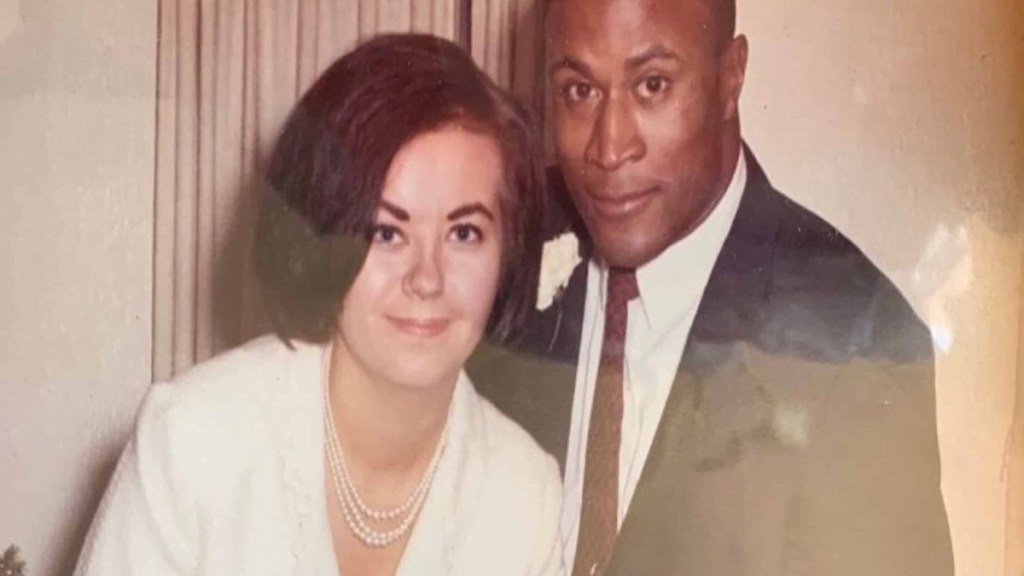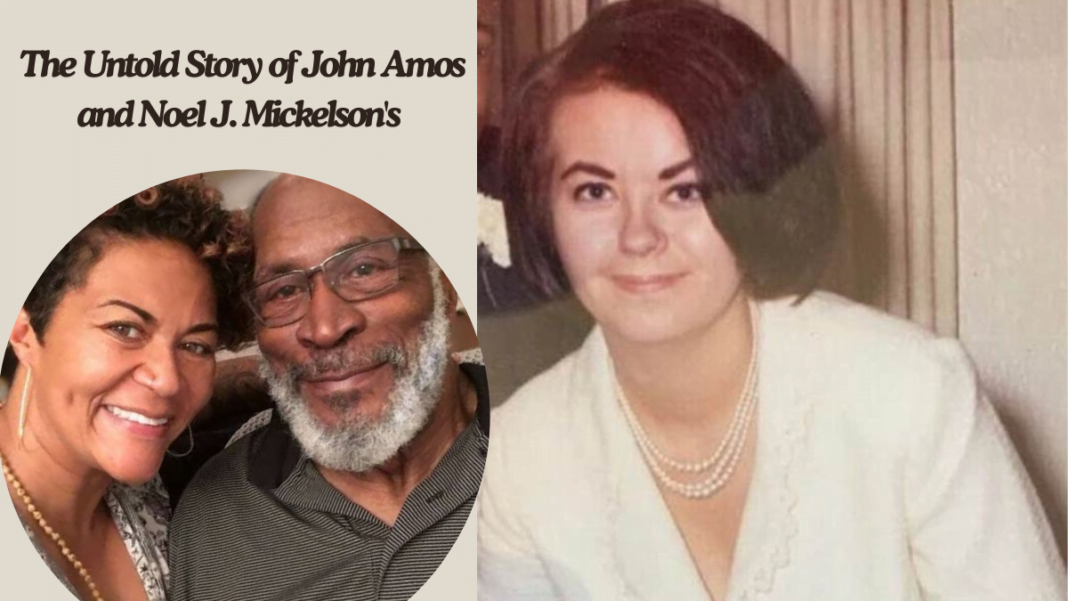Discover the tale of actor John Amos and first wife Noel J. Mickelson, navigating challenges in their interracial marriage.
Introduction
When we communicate approximately pioneering figures in American tv, John Amos certainly makes the list, not only for his roles on screen however additionally for his personal lifestyles studies that mirrored broader societal troubles. John Amos’ marriage to Noel J. Mickelson changed into more than a union of two individuals—it turned into a bold stance in opposition to the racial prejudices and legal limitations that plagued America within the Sixties. This is the tale of how their interracial marriage challenged societal norms and helped pave the manner for exchange within the panorama of marriage laws during a turbulent time in American history.
John Ammous and Noel J. Mickelson: A Love Story Defying Norms
The Relationship of John Amous and Noel J. Mickelson
John Amous, an acclaimed actor acknowledged for his roles in television collection like “Good Times,” and Noel J. Mickelson, an artist and teacher, met all through a time while the winds of social exchange were just starting to stir inside the United States. Their meeting sparked a connection that quick deepened, rooted in shared pursuits and mutual recognize for each different’s professions. Despite coming from specific racial backgrounds—Amous being African American and Mickelson being Caucasian—their bond overcame the societal norms of the Nineteen Sixties, a length while racial tensions had been excessive.
Their love tale commenced whilst both have been educators; Mickelson become coaching quality arts, and Amous changed into a social research instructor. Their conversations frequently revolved round their passions for schooling and activism, which similarly cemented their dating. Their friendship gradually blossomed into a deeper dedication, leading to their marriage. This union, filled with mutual admiration and deep understanding, stood as a beacon of hope and a statement against the existing prejudices about interracial relationships.
Challenges Faced with the aid of the Couple in Their Interracial Marriage
John and Noel’s journey wasn’t with out its limitations. Living in an technology wherein interracial unions had been frowned upon, and in lots of cases, unlawful, they confronted societal backlash that ranged from stark disapproval from their communities to outright hostility. This external pressure took numerous forms:
- Social alienation from associates and a few family contributors who have been uncomfortable with or opposed to their marriage.
- Professional repercussions where each John and Noel sometimes confronted discrimination. Noel, particularly, faced demanding situations in her career as an educator in which her desire of spouse turned into seen as arguable.
- Psychological stresses that examined their non-public and collective clear up, necessitating a robust basis of their courting and an unwavering aid gadget from open-minded buddies and allies.
Despite these trials, their dedication to one another remained unshaken, illustrating the power in their love and the precept that non-public relationships ought to transcend racial limitations.
Legal Obstacles: The Banning of John Amous and Noel J. Mickelson’s Marriage
Overview of Interracial Marriage Laws on the Time
At the time John Amous and Noel J. Mickelson decided to marry, interracial marriage became nonetheless illegal in severa states across America because of the Racial Integrity Act and different comparable legislations. These laws had been rooted in centuries-antique biases and were designed to hold racial purity. By the mid-20th century, those previous views had been being challenged, however trade became gradual and resistance become excessive.
For example, the landmark case of Loving v. Virginia, which in the end ended all race-primarily based criminal restrictions on marriage inside the United States, had now not but befell. This intended that couples like John and Noel needed to navigate a complicated and regularly unfriendly legal panorama to legitimize their union, regularly travelling to states with extra liberal laws or residing in discreet defiance of the regulations imposed by means of their home nation.
Impact on John Amous and Noel J. Mickelson
The racial laws of the time posed extensive private and prison challenges for John and Noel. They needed to carefully take into account the ramifications of their union, not just on their personal lives however also on their professional and social status. The couple regularly grappled with the worry of felony action being taken against them, that can bring about excessive consequences along with fines or maybe imprisonment.
Despite these pressures, their willpower to live as a married couple never wavered. They determined solace and guide in groups and networks that recommended for racial equality and the abolition of antiquated marriage legal guidelines. Their relationship served not most effective as personal success however also as a quiet protest in opposition to racial discrimination.
Controversy Surrounding Their Union
The marriage of John Amous and Noel J. Mickelson did not arise in a vacuum; it attracted a fair amount of media attention, which in turn motivated public opinion. Some regarded their marriage as a symbol of progress and a beacon of wish at some stage in a turbulent duration in American racial history, while others regarded it with contempt, viewing it as a task to social norms and racial identities.
The couple’s high-profile reputation due to John’s appearing career meant that their relationship become often below scrutiny, and the public’s fascination with their lifestyles collectively added extra pressures. Nevertheless, they controlled to navigate those turbulent waters with grace and resilience, becoming inadvertent pioneers inside the fight for marital equality and racial concord in America.
Legacy of John Amos and Noel J. Mickelson’s Marriage
John Amos, a respected actor recognized for his role as James Evans Sr. On the long-lasting tv series “Good Times,” and Noel J. Mickelson, a high school trainer with a passion for artwork and activism, embarked on a direction that few had dared to tread in their time. Their interracial marriage for the duration of the early 1970s within the United States stood as a beacon of exchange amidst stringent anti-miscegenation laws that still lingered in a few states.

Despite the societal demanding situations and criminal restrictions gift throughout the a long time of their union, Amos and Mickelson’s relationship turned into a lot more than a mere symbol of defiance; it changed into a demonstration of affection’s transcendence over racial barriers. Their marriage bore youngsters and provided a platform for both of them to talk about and address the complexities of race relations in America, both of their community and, through Amos’ platform, on a bigger scale.
Breaking Barriers: Paving the Way for Interracial Couples
The union among John Amos and Noel J. Mickelson occurred for the duration of a pivotal era in American history. The Supreme Court’s 1967 landmark selection in Loving v. Virginia had simplest these days struck down legal guidelines banning interracial marriage, yet societal reputation lagged a ways behind prison permissions. Against this backdrop, Amerson and Mickelson’s bravery stood out even greater conspicuously.
- Cultural Impact: Their public appearances and the media coverage round their marriage helped normalize interracial relationships for plenty Americans. They effectively challenged the stigmatization of such relationships, showcasing that love ought to now not be limited with the aid of racial strains.
- Inspiration to Others: Many interracial couples credit pioneers like Amos and Mickelson with paving the way for his or her own relationships. Their tale has been referenced in numerous cultural studies and moves advocating for racial equality and social justice.
- Media Representation: John Amos, through his roles and interviews, often mentioned the importance of variety and recognition, subtly weaving the integrity of his real-existence interracial marriage into his expert narrative.
Lessons Learned from Their Story
The marriage of John Amos and Noel J. Mickelson provides a wealth of instructions about love, resilience, and societal development:
- Resilience inside the Face of Adversity: One of the maximum resonant takeaways from their tale is the strength of status firm in the face of adversity. Despite capability personal and expert repercussions, they maintained their bond.
- The Power of Visibility: By sincerely being collectively, Amos and Mickelson confirmed the normalcy and beauty of interracial relationships. Their visibility became a powerful tool in converting perceptions and promoting social trade.
- Educational Impact: Their tale has stimulated multiple academic discussions approximately race, love, and law, emphasizing the continuing talk essential for societal increase.
By considering the overarching narrative of John Amos and Noel J. Mickelson, it’s clean that the demanding situations they confronted had been massive, however equally considerable became their courage in confronting these challenges. Their legacy maintains to encourage and inform discussions on race family members and marital freedoms today, underscoring the iconic importance of their story within the persevering with fight for equality and expertise.
Conclusion: Remembering the Courage of John Amos and Noel J. Mickelson
The story of John Amos and Noel J. Mickelson is more than just a tale of love; it is a profound reminder of the braveness and resilience required to mission societal norms. Their marriage, set towards the backdrop of restrictive and prejudiced legal guidelines, stands as a testomony to their commitment no longer just to each as partners however additionally to their beliefs in justice and equality.
Their journey, fraught with demanding situations, helped pave the way for future generations to marry whom they love, irrespective of race. As we replicate on their lives and the boundaries they overcame, we are able to draw thought to continue pushing towards the bounds of prejudice and discrimination in our own time. Their legacy teaches us the electricity of affection and the importance of preventing for what is proper, encouraging us all to stand firm in our convictions and to foster inclusivity in our groups.






